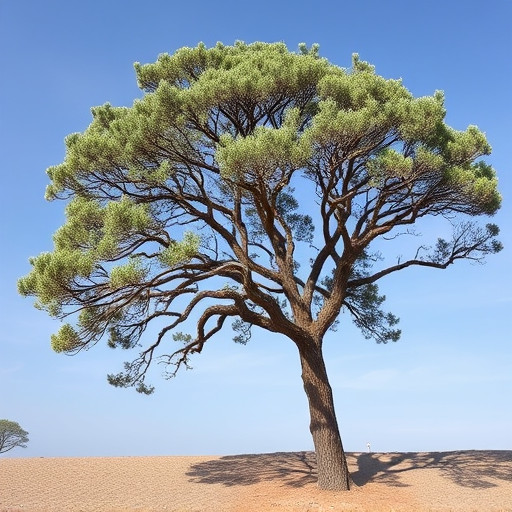The California Acacia (Acacia californica) is a native tree unique to California, known for its drought-resistant traits and feathery leaves. It thrives in diverse habitats, from dry regions to coastal areas, thanks to its deep root system and adaptations like thick waxy leaves and reflective bark. Unlike its non-native relative, the Indian Acacia (Acacia nilotica), which prefers humid subtropical environments, the California Acacia has evolved to dominate arid climates with unique physical and ecological characteristics.
Acacia in California vs. India: A Comparative Study
The Acacia tree, a resilient and diverse genus with global distribution, presents intriguing variations across different continents. This article explores the distinctive characteristics of two distinct Acacia species: the native California Acacia (Acacia californica) and its exotic counterpart, the Indian Acacia (comprising various Acacia species indigenous to India). By comparing their physical attributes, environmental adaptations, ecological roles, and cultural significance, we uncover the unique traits that set these trees apart, despite sharing a common genus. This comparative analysis highlights the richness of plant biodiversity within the Acacia family, as well as the varying relationships they forge with their respective environments and human cultures.
- California Acacia: A Native Species
- – Description and distribution in California
- – Unique adaptations to the local climate and ecosystem
- Indian Acacia: An Exotic Counterpart
California Acacia: A Native Species

The California Acacia (Acacia californica) is a native species of mesquite tree found throughout much of the state. It’s a member of the Fabaceae family, known for its distinctive thorny branches and feathery, compound leaves. This tree plays a vital role in California’s ecosystem, providing habitat and food for various wildlife, from birds to insects. Its adaptability to different soil types and drought conditions makes it well-suited to the region’s climate variations.
Unlike many non-native acacia species, the California Acacia has evolved alongside the state’s unique flora and fauna over thousands of years, leading to distinct characteristics that set it apart from its Indian counterparts. These differences include not only physical traits but also ecological roles and cultural significance within the local environment.
– Description and distribution in California

The Acacia tree is native to California and is a common sight across the state’s diverse landscapes. This species, scientifically known as Acacia macrocalyx, thrives in various habitats, from dry, arid regions to coastal areas with moderate temperatures. In California, it grows as a medium-sized tree, reaching heights of up to 30 feet, with a spread of several branches. Its leaves are compound and feathery, providing a distinctive appearance. The tree’s rough, fissured bark adds to its unique visual appeal.
Unlike its Indian counterpart, the California Acacia has adapted to the region’s specific environmental conditions. It is well-suited to drought, possessing deep root systems that enable it to access water sources far below the surface. This adaptability has made it a resilient and widespread presence in California’s ecosystem, offering habitat for various wildlife species and contributing to the state’s unique botanical identity.
– Unique adaptations to the local climate and ecosystem

The Acacia tree, native to California, has unique adaptations that set it apart from its Indian counterpart. One of its most distinctive features is its ability to thrive in the state’s arid climate, where it has developed efficient mechanisms to conserve water. These adaptations include a deep and extensive root system that taps into underground water sources and thick waxy leaves that reduce water loss through transpiration. In addition, the tree’s small, spines-covered leaves and bark help to reflect sunlight and prevent excessive heating, allowing it to withstand the region’s hot summers.
These evolutionary adjustments enable the California Acacia to flourish in ecosystems characterized by sparse rainfall and high temperatures, contrasting with the diverse and often humid conditions found in India where various Acacia species originate. This specialization ensures the tree’s survival and dominance in its local habitat, contributing to the unique flora of California.
Indian Acacia: An Exotic Counterpart

The Indian Acacia, scientifically known as Acacia nilotica, is a fascinating tree species native to the tropical regions of Asia and Africa. This exotic counterpart shares some similarities with its California cousin, but it also presents distinct characteristics that set it apart. One notable difference lies in their ecological niches; while the Acacia tree in California has adapted to the arid conditions of the desert, the Indian Acacia thrives in moist, subtropical environments, often found along rivers and wetlands.
Visually, both trees exhibit a similar structure with their spreading branches and dense foliage. However, the Indian Acacia tends to grow taller, reaching heights up to 30 meters, and has broader leaves with distinct veining. Its bark is also characterized by deep fissures, adding a unique texture compared to the smoother bark of its California counterpart. These differences highlight the remarkable diversity within the Acacia genus, showcasing their ability to evolve and adapt to diverse global environments.
The Acacia tree, native to California, exhibits unique adaptations to its local climate and ecosystem, setting it apart from its exotic counterpart, the Indian Acacia. While both share physical characteristics, their environmental niches and cultural significance differ significantly, reflecting the diverse landscapes and histories of their respective regions. Understanding these distinctions highlights the complexity and beauty of biodiversity worldwide.
